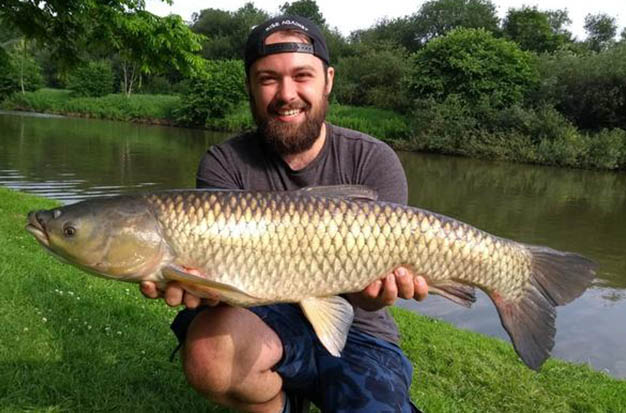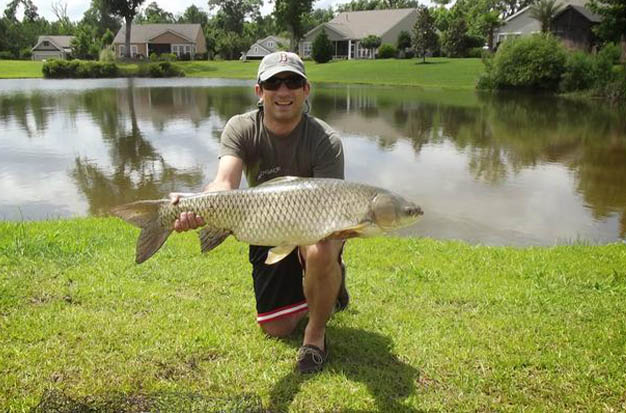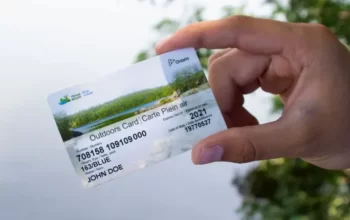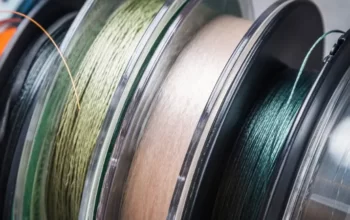Anglers have a tendency to have a mixed opinion of catching grass carp. Others haven’t even given grass carps the time of day, while some go on trips specifically designed to catch them. As for BassGrab, we often compare grass carp to redfish because of the way they tail through the grass during a flood, how much they bend your rod, and the fact that their scales often have a golden red hue.
For all those who like a real fishing challenge, grass carp is one of the TOP choices.
Larger specimens look very impressive and you will be able to show off with your catch in front of your friends and family!
Grass carp is not easy to catch, and you have to be prepared for a hard fight.
From fishing gear choice, to perfect bait, everything has to be suitable for the task. Additionally, you will require a lot of patience and good fishing skills.
To know more about how to catch grass carp, read the following chapters:
Table of Contents
What Are Grass Carps?
A type of carp that is frequently bred for eating and fishing is the grass carp. Although it is rarely eaten in Britain and is primarily regarded as a “coarse fish,” it is consumed in a number of other nations.
Physical Characteristics
The grass carp, also known as Ctenopharyngodon idella, is a sizable fish. It gets its scientific name because of pharyngeal teeth. While its body is covered in thick scales, its head is unscaled. Its body is oblong in shape, like a torpedo. It can weigh as much as 88 lb and is fairly chubby. It has a forked tail.
It has a lighter, white belly and is greenish-brown or olive in color. There are some silver-colored grass carp. It lacks barbels and does not have the fleshy lips that are characteristic of other carp species. The scales on the side and back are lined with a dark color, giving the scales an outline appearance.
Habits
Although grass carp prefers to eat plants, if it cannot find enough plant food, it will consume insects or fish eggs. It consumes up to three times its body weight on a regular basis and is a voracious eater. The majority of nations introduce grass carp to slow the spread of unchecked aquatic vegetation.
Grass carp typically inhabit freshwater streams, swift rivers, lakes, and ponds because they can find enough aquatic vegetation and favorable spawning conditions there. The ideal temperature range for grass carp to spawn is between 20°C and 30°C.
The eggs must float during incubation because they perish if they sink to the bottom. For this reason, it lays its eggs in water that is moving quickly.
Although they can continue to grow for much longer than two years, grass carp typically take two years to mature.
What Do Grass Carp Look Like?
Grass carp originates from Asia. This big herbivore fish was introduced to Europe and the USA to be used for aquatic weed control.
Their body shape is elongated and thick. For a fish of this size, the eyes are quite small and positioned in the middle of the sides of the head.
Their lips are firm and they have no barbels. Along the length of their bodies, grass carp have large, overlapping scales, where the longest, lateral, line has between 40 and 42 scales. Between 8 and 10 rays make up their dorsal fin.
Colour can vary from dark olive green and grey on the back, to brown/yellow on the sides. The grass carp’s bottom is largely white and light in color. Sometimes the sides can appear silvery.
Grass carp grows extremely fast, and usually grow between 60 – 100 centimetres (1.9-2.3 ft), although longer ones have been observed. The weight of grass carp can be up to 40 kilograms.
How Do They Vary From Other Carp Species?
Due to its distinct feeding preferences, grass carp distinguishes itself from other species. It mainly eats aquatic vegetation and is an herbivore. The majority of other species of carp, in contrast, are omnivorous and consume aquatic plants as well as invertebrates, crustaceans, small fish, and fish eggs.
Additionally, grass carp consume more food than other carp species. Up to 40% of its body weight can be consumed by food. Its excrement can result in algal blooms because the food is only partially digested. Because of this behavior, it frequently contributes to ecosystem imbalances.
When reeled in, grass carp are also a very spirited opponent. The majority of anglers view catching grass carp as a fun challenge because of how violently it thrashes.
Beginner anglers frequently mix up the various species of carp. Many species, including the common and grass carp, have very similar appearances and can be difficult to distinguish. Let’s be real, then. When a carp is thrashing on the line, it is already challenging to determine its exact species.
That’s where we come in, though. Since the common carp is the species that people most frequently confuse it with, let’s contrast the two species’ differences.
What Size Can Grass Carp Reach?
For industrial purposes, grass carp, a species of freshwater fish, have been introduced into numerous nations. Although they are large herbivores that can get up to 48 inches long and weigh more than 20 pounds, they primarily consume plants rather than meat.
Grass carp have a very large size! In Illinois, USA, a massive grass carp over 100 pounds in weight was once caught. That is more weight than the majority of men!
The typical grass carp weighs between 30 and 50 pounds. The vast majority of giant ones are female.
They put up a good fight, making fishing for large female grass carp enjoyable. On the other hand, you should concentrate on catching small grass carp if you want to catch the largest ones. Smaller fish typically have better bites!
Are Grass Carp Hard To Catch?
It can be very challenging to catch grass carp. To consistently land them, you need the appropriate tools and a sound plan of action.
But because we’ll walk you through every step, all you’ll need to do is put what you’ve learned into practice to see the grass carp take off.
Each week, we spend many hours fishing and test every piece of gear we own before deciding whether it’s suitable for this website.
Before placing your order, check the product reviews to make sure it’s the right one for you.
Where Can I Fish For Grass Carp?
Actually, eastern Asia is where grass carp are native. They were imported to the country to aid in weed management in ponds and lakes. As soon as they appeared, they flourished and eventually turned into a problem species. Except for Alaska, Maine, Montana, Rhode Island, and Vermont, they can be found throughout the entire United States.
Grass carp favor habitats with shallow freshwater, such as lakes, ponds, and even retention ponds. Most grass carp in the US are infertile and are only stocked in lakes and ponds to inhibit weed growth.
When Is The Most Effective Time To Catch Grass Carp?
Because grass carp are out feeding in the morning when it is light enough for them to see their food, you must be aware of the best times to catch them.
In addition, they are more active in the morning compared to the evening, and they move more slowly when there is not enough light.

The Best Rigs And Tactics To Catch Grass Carp
The similarities between the grass carp and the common carp end there, though. You’ll need the right tools to ensure that your attempt to catch a grass carp is successful because it can be quite difficult to do so.
Rigs
To begin with, check that your fishing line is long because grass carp frequently float in deeper water. If they are migrating or spawning, they only move in shallower waters.
You will also need:
- A 20-30 lb test fishing line (preferably monofilament or fluorocarbon)
- Circle hooks
- A reel that will let you extend your line up to 200 yards
- A chod rig if you’re fishing in weeds
- A hair rig if you’re just starting out
- An adjustable zig-rig to fish near the surface
Fishing lines that are not readily visible, like fluorocarbon lines, are preferred by the majority of anglers. Circle hooks are the ones that work best for a grass carp’s mouth, so you’ll see them used when carp fishing. Furthermore, because grass carp are naturally very suspicious and won’t bite if anything doesn’t look right, be sure to completely cover your hook with the bait so that no part of the hook is visible.
Pre-baiting
By now, everyone is aware of how much grass carp enjoy eating plants. Pre-bait the area with sweetcorn a few days beforehand so that the grass carp get accustomed to feeding there to ensure that you catch some excellent fish on your fishing day.
Making bait balls out of sweetcorn and breadcrumbs and pre-baiting the area with them will add extra punch.
Tactics
After discussing the appropriate baits and equipment, let’s move on to the strategies you should employ to successfully catch grass carp. You won’t have much trouble catching grass carp if you just relax. Follow these strategies, and when your line appears with a massive, struggling grass carp on it, make sure your camera is ready to take pictures!
Then let’s start the process!
Sight Fishing
If the water is clear enough, you can stalk grass carp. If you’ve already pre-baited the area, you might see some grass carp swimming around close to the surface. Carp will swarm to the bait if you cast about six feet in front of them.
Since you can see exactly where to cast and what to do to get the carp to bite, sight fishing is a very rewarding technique. To avoid scaring grass carp, make sure to cast close to the fish rather than directly at it.
Traditional methods can also be used to catch grass carp.
Bait For Grass Carp
Grass carp are vegetarians and are known for removing vegetation from ponds and lakes, unlike largemouth or spotted bass. The use of lettuce or even grass clippings as bait by anglers has been reported. However, the following lures are guaranteed to be effective:
- Sweet Corn – Place two or three on your tiny hook to hide it.
- Cherry Tomatoes – To again accommodate your hook, cut these in half or quarters.
- Watermelon – These ought to resemble a small hook, you guessed it.
- Earth Worms – In fact, these worms can be of normal size; however, once more, make sure the hook is concealed.
- Dough Balls – Do we even need to say it? Make certain that it extends past your hook.
- Man-Made Bait – Follow the directions they provide. (Cover the hook)
Fishing Techniques For Grass Carp
As you can see below, grass carp can be simple to spot in the sun, but that doesn’t necessarily make them simple to catch. Unless you enjoy bow fishing, that is. But if you’re using a rod and reel, you’ll be in the best position to catch a grass carp if you’re patient, quiet, and chumming.
Chumming
Use this as chum along with whatever bait you choose to use. Since it is inexpensive and doesn’t smell bad, sweet corn is our go-to bait. At least four days prior to fishing there, scatter a can or half of a can of corn in the area. The carp will gather there and be waiting for your corn when you get back.
Wait patiently and keep quiet when you return to fish. Then you can unwind while the large fish find your bait by setting up your rod holders and setting a fishing alarm.
Sight Fishing
If the lake or pond where you are fishing is sufficiently clear, you can stalk your prey. This approach is our favorite because it’s exciting and rewarding to see a carp take your bait. On a fly rod, this is the best method for catching them.
They occasionally swim in the flooded grass while even having their fins out of the water like a redfish. When not feeding, they will additionally hang out on top of the water.
You should still use your bait to chum the area or pond where you are fishing in order to whet the carp’s appetite for whatever you decide to use as bait. Use just enough weight to be able to throw it approximately 6 feet in front of the carp and get them to approach it. Others prefer to use a small bobber so they can see when the carp has taken a bite.
Tips And Tricks To Catch Grass Carp
Like everything else, there are techniques that can help you catch grass carp. If you’ve been on the banks for any length of time, you’ve probably run into some friendly old-timers who are happy to share their knowledge with you. That’s why it’s often said that learning everything there on the water is the best place to learn about carp fishing.
What advice did we learn while carp fishing about catching grass carp? Let’s find out.
Fish In The Warmer Months
Grass carp are typically active only during the summer. Use the open season to catch grass carp right away if you only want to catch them. During the winter, they are remarkably apathetic and are unlikely to take any bait.
Find Sluggish Waters
Grass carp prefer to live in areas with still water. Aquatic vegetation, which serves as their main food source, is typically abundant in these locations. Try your luck in lakes or rivers with slow currents if you want to find grass carp.
Make Sure There’s No Drag
Because grass carp are quite wary and will flee if they sense even the slightest amount of stiff resistance, use a free-spool line that is guaranteed to have zero drag. You won’t be able to tell if anything bites the line after you remove the drag. Keep a finger on the line to detect bites and prepare to strike a fish that is moving to counteract that.
Cover The Hook
If you’re using a hook to attach bait to catch grass carp, be sure to completely cover it up. The carp will flee if they spot even a tiny bit of something suspicious.
Camouflage Yourself
Grass carp have keen vision and can detect motions outside of the water. Wear neutral colors and avoid sudden movements that might frighten the carp if you intend to surface fish.
That’s all the knowledge we have at this time regarding how you can be successful in catching lots of grass carp.
Conclusion
With the knowledge of how to catch a grass carp in your arsenal, we hope this guide has been useful. These fish can usually be caught in less than 10 minutes, so there is no need to be intimidated by them.
The bottom line is that, if you know what to do, catching grass carp can be simple! Here are a few pointers for newcomers. -These straightforward steps will help you catch them (a thorough beginner’s guide to grass carp fishing). Catching one fish is not difficult when using the proper technique and bait, despite the fact that it might seem difficult.




